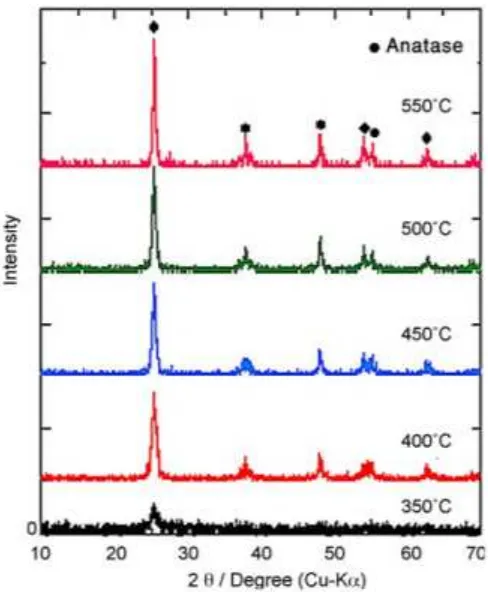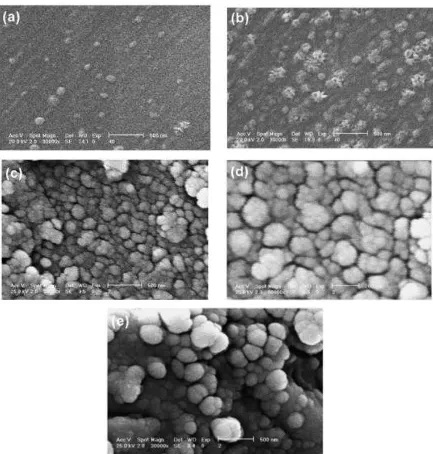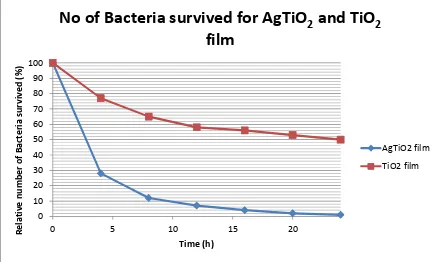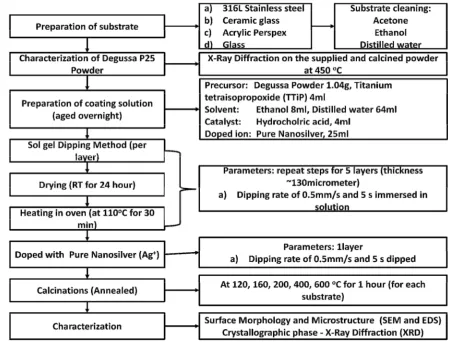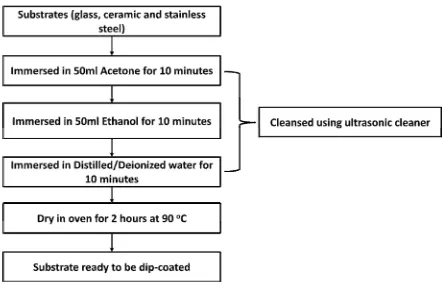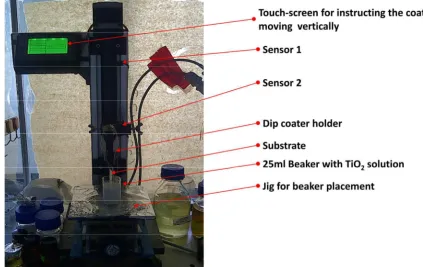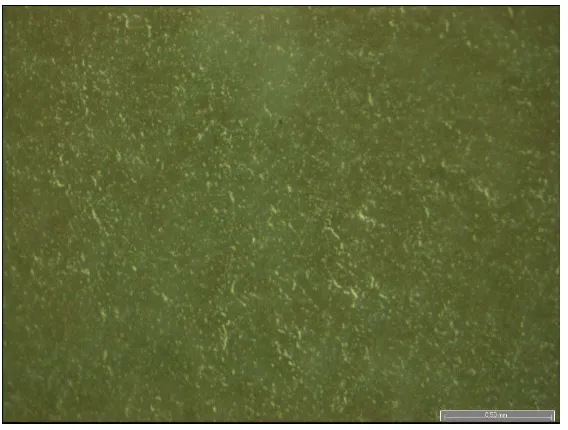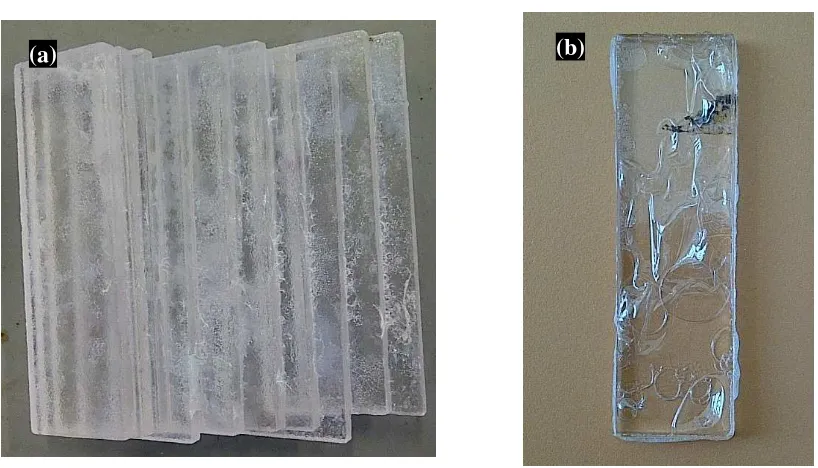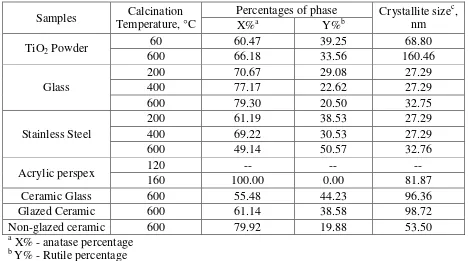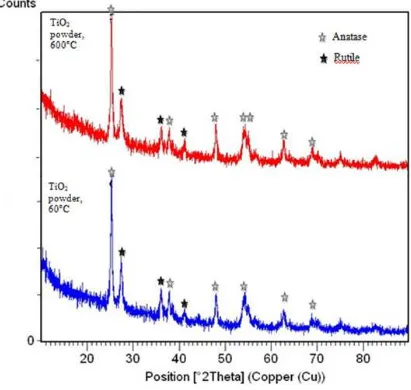Faculty of Manufacturing Engineering
CHARACTERIZATION STUDY OF SILVER TITANIUM DIOXIDE
(AgTiO
2) THIN FILM DEPOSITED ON VARIOUS SUBSTRATES VIA
SOL-GEL TECHNIQUE
Fatimah Md Radzai
Master in Manufacturing Engineering (Industrial Engineering)
ii
CHARACTERIZATION STUDY OF SILVER TITANIUM DIOXIDE
(AgTiO
2) THIN FILM DEPOSITED ON VARIOUS SUBSTRATES VIA
SOL-GEL TECHNIQUE
FATIMAH MD RADZAI
A thesis submitted
in fulfillment of the requirement for the degree of Master of
Manufacturing Engineering (Industrial Engineering)
Faculty of Manufacturing Engineering
UNIVERSITI TEKNIKAL MALAYSIA MELAKA
iii
ABSTRACT
Anatase Titanium Dioxide (TiO2) sol was synthesized in room temperature 27°C and
ambient pressure by hydrolysis of Titanium Tetraisopropoxide (TTiP) in acidic aqueous solution (Hydrochloric acid, HCl), ethanol and deionized water. Degussa P25 powder was used as a precursor to enhance the anatase presence in the crystalline phase, as Degussa P25 powder is comprised of anatase and rutile phase with the ratio of 70:30. At room
temperature and in ambient atmosphere, crystalline TiO2 thin films were deposited on
Acrylic Perxpex (AP), glass, stainless steel and ceramic from the as-prepared TiO2 sol by a
dip-coating process. TiO2 layers on the substrate were thickened by consecutive coatings.
Then the TiO2 coated substrates were finally dipped into pure nanosilver to ensure
protection against microbial. Sintering was applied at different temperatures from 120 to
600 °C in order to enhance crystallization. AgTiO2 thin film is found to be in good
adhesion to the substrates through means of ultrasonically immersed in water and sticky tape adhesion. Anatase crystallite size was calculated through full-width at half-maximum (FWHM) in the X-ray Diffraction (XRD) intensities of anatase (101) peak at 2 = 25.3° using Scherrer equation. The increase in calcinations temperature is parallel with the increase of the crystallite size. The anatase/rutile percentage was calculated through anatase and rutile intensities, to show the coherent ratio relevant to the Degussa P25 powder presence. Field-emission type scanning electron microscope (FE-SEM)
investigations revealed that the AgTiO2 thin films on each substrates were porous and
uniform, while the average particle sizes of the nanoparticles composing the AgTiO2 thin
films on different substrates are in range of 37~87 nm corresponding with the calculated
particles achieved by the Scherrer equation. The AgTiO2 thin films exhibited smooth
iv
ABSTRAK
Cecair anatase Titanium Dioxide (TiO2) telah di sintesis pada suhu dan tekanan bilik
melalui proses percampuran Titanium Tetraisopropoxide (TTiP) ke dalam Hidroklorik asid (HCl), etanol dan air suling. Serbuk Degussa P25 yang komersial telah digunakan sebagai
pemangkin untuk membantu pembentukan anatase kristal dalam fasa penkristalan. Pada
suhu dan tekanan bilik, substrat yang berlainan seperti Acrylic Perspex (AP), potongan
gelas, keluli tahan karat dan seramik di celup ke dalam cecair TiO2 melalui proses celupan
yang terkawal. Sebanyak 5 celupan telah dilakukan untuk menghasilkan ketebalan saput nipis yang optima pada permukaan substrat. Pemanasan dan pengkalsinan pada suhu 120
sehingga 600 °C telah dilakukan terhadap substrat yang telah dicelup dengan AgTiO2. Ini
adalah untuk memastikan proses pembentukan anatase kristal berlaku. Saput nipis AgTiO2
didapati dalam keadaan yang baik iaitu ia melekat dengan sempurna terhadap semua permukaan substrat. Saiz kristal anatase telah dikira menggunakan data yang didapati melalui data belauan sinar x (XRD) iaitu nilai FWHM pada anatase (101) yang sepadan dengan nilai pada darjah 2 = 25.3°. Nilai yang didapati dikira menggunakan persamaan Scherrer. Apabila suhu pengkalsinan meningkat, saiz anatase kristal juga akan meningkat. Pengiraan terhadap nisbah anatase/rutile juga dilakukan untuk menunjukkan keseragaman terhadap penggunaan serbuk Degussa P25. Penggunaan pancaran medan kemikroskopan
electron imbasan (FE-SEM) telah menunjukkan bahawa saput AgTiO2 adalah berliang dan
seragam. Manakala, saiz nilai purata zarah pada saput tersebut di dapati dalam lingkungan
37~87 nm, iaitu sama dengan kiraan partikal kristal menggunakan persamaan Scherrer.
Saput nipis AgTiO2 merangkumi permukaan yang berliang dan seragam dan juga
v
ACKNOWLEDGEMENT
I would like to thank Dr Zulkifli Mohd Rosli and Associate ProfessorDr Jariah Mohamad
Juoi for being such enthusiastic and involved supervisors throughout the course of my
short master research. Thank you both for the continual guidance, encouragement and advice. I also thank Universiti Teknikal Malaysia Melaka (UTeM) and Kementerian Pengajian Tinggi (KPT) for awarding me the fellow scholarship throughout my journey in furthering master studies.
Many people have helped me out along the road in completing this work. My first thanks
must go to my partner in research, Norhamizah Mohd Rusli - thank you for the
never-ending discussion and for sharing the research experience. There are abundant of people who had assisted me here and I extend my gratitude to them. Everyone at UTeM, Faculty
of Manufacturing Engineering, Manufacturing Material Lab, in particular: En Hairul, En
Azhar and En Jaafar for the usage and assistance in XRD, SEM and CMM, AMREC
SIRIM Hi-Tech, Dr Kadir, Puan Suhaina and Cik Farina for the assistance in the sol-gel
dipping method, University of Technology Malaysia (UTM), UTM Department of
Mechanical Engineering, Dr Muhammad Azizi Mat Yazid for the assistance in gold coating
of the specimen, En Jefri (FESEM UTM) and of course my fellow UTeM fellowship
scholars, Nurul Izuwa and Nor Fadzilah for the advice and support. My final thanks must
vi
APPROVAL
This report is submitted to the Faculty of Manufacturing Engineering of UTeM as a partial
fulfillment of the requirements for the Master of Manufacturing Engineering (Industrial
Engineering). The member of the supervisory committee is as follow
………….……….
DR ZULKIFLI MOHD ROSLI
vii
DECLARATION
I declare that this thesis entitle “Characterization study of AgTiO2 thin film coating
deposited on various substrate via sol-gel technique” is the result of my own research except as cited in the references. The thesis has not been accepted for any degree and is not concurrently submitted in candidature of any other degree.
Signature : ……….
Name : ……….
viii
1.6 Significance of Study and Application 5
2. LITERATURE REVIEW 6
2.1 Antimicrobial coating 6
2.2 Types of antimicrobial application 7
2.3 Substrate Surface Application 7
ix
2.3.2 Glass 8
2.3.3 Ceramic 8
2.3.4 Polymer - Acrylic Perspex 9
2.4 Formulation of Ag-TiO2 10
2.4.1 Sol-gel dipping method 10
2.4.2 Degussa P25 powder 12
2.4.3 TiO2 Sol Preparation 13
2.4.4 AgTiO2 sol preparation 14
2.4.5 AgTiO2 thin film layers on different substrates 15
2.5 Material Characterization techniques for AgTiO2 coating 16
2.5.1 Appearance and mechanical properties 16
2.5.2 X-ray Diffraction (XRD) 17
2.5.3 Scanning Electron Microscopy (SEM) 19
2.6 Antimicrobial activity testing 20
3. MATERIALS AND METHODOLOGY 23
3.1 Schematic flow Chart of the Project 23
3.2 Substrate material preparation 24
3.2.1 Acrylic Perspex 25
3.2.2 Glass 25
3.2.3 Metal (316L Stainless Steel) 26
3.2.4 Ceramics 27
3.3 Sol-gel AgTiO2 coating preparation 28
3.4 Sol-Gel dip coating to produce thin films of AgTiO2 29
x
3.6 Thin film characterization 34
4. RESULT 35
4.1 Degussa P25 powder characterization 35
4.2 AgTiO2 thin film mechanical and physical observation 39
4.2.1 AgTiO2 sol gel observation 39
4.2.2 Observations on coating 40
4.2.3 Stainless steel 43
4.2.4 Glass 47
4.2.5 Ceramic 47
4.2.6 Acrylic Perspex 48
4.3 XRD characterization of AgTiO2 powders and thin films 49
4.3.1 Characterization of TiO2 sol particles 50
4.3.2 XRD Characterization of AgTiO2 thin films 53
4.4 SEM surface morphologies of AgTiO2 thin film and TiO2 powders 61
4.5 EDS composition in AgTiO2 thin film on different substrate 67
5. DISCUSSION 71
5.1 Surface morphologies of TiO2 thin films on different substrates 71
5.2 XRD Characterization of the AgTiO2 thin films 72
6. CONCLUSION AND RECOMMENDATION 74
6.1 Conclusion 74
6.2 Recommendation 75
REFERENCES 76
xi
LIST OF FIGURES
FIGURE TITLE PAGE
2.1 Schematic representation of the sol-gel process (Page, et al., 2009) 11
2.2 Schematic representation of the Sol-Gel preparation of a thin film
by dip coating (Page, et al., 2009)
12
2.3 XRD patterns of the TiO2 thin films calcined at different
temperatures (Barati, et al., 2009)
18
2.4 SEM Micrographs of TiO2 thin films calcined at various
temperatures for 1h: (a) 350oC; (b) 400oC; (c) 450 oC; (d) 500 oC;
(e) 550 oC, (Barati et al, 2009)
20
2.5 In case of E. coli, relative number of bacteria survived for TiO2
films and Ag/TiO2 film (Sun, et al., 2008)
21
2.6 Antibacterial activity of Ag-TiO2 films, test results on E.Coli after
24hr: (a) incubated with a ceramic tile, (b) incubated with TiO2
film and (c) incubated with Ag–TiO2 film (Sun, et al., 2008)
22
3.1 Schematic Project Flow-chart 23
3.2 Substrate surface cleaning process 24
3.3 Acrylic Perspex before coated 25
3.4 Glass substrates before coated with thin film 26
3.5 Sample surface polishing preparation for metal; 316L Stainless
Steel
27
xii
thin film (a) Glazed ceramic (b) glass ceramic (c) Non-glazed ceramic
3.7 Procedure of preparation for coating solution 29
3.8 Sol-gel dip-coating procedure 30
3.9 Sol gel Dip-coater machine 31
3.10 Steps of immersion dip coating procedure.: (a) substrate in
90degree moving vertically downwards towards solution (b) substrate immersed in solution (c) substrate moving out from solution
32
4.1 Powder XRD of Degussa P25 powder – peak assignments confirm
anatase and rutile phases of TiO2
37
4.2 Powder XRD of Degussa P25 powder calcined at 450oC for 1 hour
– peak assignments confirm anatase and rutile phases of TiO2
38
4.3 Physical observations of the AgTiO2 coated substrates (a) Stainless
Steel (b) Glass (c) Acrylic Perspex (AP) (d) Non-glazed ceramic (e) glazed ceramic
42
4.4 Stainless steel substrates after grinded and polished 44
4.5 Optical Microscopy images (10x magnification) of Stainless Steel
coated with TiO2 Degussa P25, after coating in first layer (a)
Heated in oven for 30 minutes at 110oC and (b) dried in electronic
dry cabinet at 45% humidity, 30oC for 24 hours
45
4.6 Optical Microscopy images (10 x magnifications) of 5 layer coated
stainless steel substrate, calcined at 600oC (a) dried in oven (b)
dried in room Temperature
46
4.7 Optical Microscopy images of glass substrate, calcined at 600oC 47
4.8 Optical Microscopy images of ceramic substrate, calcined at 600
°C
47
xiii
(a) immersed in acetone (b) heated in oven for 1 hour at 200 °C
4.10 XRD pattern of AgTiO2 powder – calcined at 60 and 600 °C 51
4.11 SEM images of TiO2 powder dried at 60 °C 52
4.12 SEM images of TiO2 powder dried at 600 °C 52
4.13 Glancing angle XRD pattern of AgTiO2 thin film coated onto
Glass calcined at 200, 400 and 600 °C
54
4.14 Glancing angle XRD pattern of AgTiO2 thin film on Acrylic
Perspex calcined at 120 and 160 °C
56
4.15 Glancing angle XRD pattern of AgTiO2 thin film coated onto
stainless steel - calcined at 200, 400 and 600 °C
57
4.16 Glancing angle XRD pattern of AgTiO2 thin film on Glazed
Ceramic calcined at 600 °C
59
4.17 Glancing angle XRD pattern of AgTiO2 thin film on Non-Glazed
Ceramic calcined at 600 °C
60
4.18 Surface FE-SEM images of a 5-coat dip-coated AgTiO2 thin film
on AP (a) calcined at 120 °C (b) calcined at 160 °C
62
4.19 Surface FE-SEM images of a 5-coat dip-coated AgTiO2 thin film
on Glass (a) calcined at 200 °C (b) calcined at 400 °C (c) calcined at 600 °C
64
4.20 Surface FE-SEM images of a 5-coat dip-coated AgTiO2 thin film
on Stainless Steel (calcined at 600 °C)
66
4.21 EDS of AgTiO2 thin film on Acrylic Perspex calcined at 160 °C 68
4.22 EDS of AgTiO2 thin film on Glass calcined at 600 °C 69
xiv
LIST OF TABLES
TABLE TITLE PAGE
2.1 Acrylic properties (courtesy from Wikipedia and CV Plastic
website)
9
3.1 Types, chemicals and the volume needed for an AgTiO2
preparation
28
3.2 Total samples and characterized by annealing temperatures 34
4.1 Thickness of AgTiO2 thin film 43
4.2 AgTiO2 powder and thin films phases and crystallite size, at
different calcined temperatures
1
antimicrobial coating, specifically with Silver Titanium Oxide (AgTiO2) is still under
research and development. The addition of silver (Ag) to the titanium oxide (TiO2) formula
has been known for its antibacterial properties, and silver nanoparticles offer superior
antibacterial activity while being non-toxic.
The importance of surface contamination is quite serious in the healthcare industry,
thus providing greater care for us to inhibit in such cleaner environment. These substrates,
non-metallic or metallic material, has a capability to be contaminated with a handful of
bacteria. In most researches, these coatings demonstrated efficient antibacterial activity
toward Escherichia coli (E. coli) and Staphylococcus aureus (S. aureus). The antibacterial
property is important for hospitals and other public buildings that are prone to bacterial
2
1.2 Role of Surfaces of Substrate
For years, researchers and scientists had believed the importance of surface in the
pool of microbes implicated in the wide variety of hospital applied infections. The role of
surfaces of substrates used in healthcare industry and household applicants are widely
known for its cleanliness. There are also other applications for metallic and non metallic
substrates of 316L stainless steel, glass, ceramics and acrylic.
Many researchers have developed various methods to apply Titanium Oxides (TiO2)
coating on various substrates. Thus, TiO2 was deposited on ceramic,fiber glass, glass and
sand, quartz and stainless steel,pebbles, activated carbon, polyester fabric using polyvinyl
alcohol as binder and Ti–TiO2 prepared by thermal as well as flame oxidation of Ti sheet,
silica, polystyrene beads and cellulose-based non-woven supports, photocatalytic1 paper,
pulp, and TiO2 coated cotton/cellulose fibers (Neti & Joshi, 2010). These substrates were
chosen based on their properties and significance of applications.
1.3 Thin films of AgTiO2 on substrate
Solid thin films has been in various investigations and titanium oxide (TiO2) has
been studied with regards to their amazing optical, electrical and photo-electrochemical
properties. The addition of silver (Ag) to the composition was due to its conductive layer
because of its low absorption in the visible region (Sun, et al., 2008).
TiO2 thin films have been a source of interest in environmental cleaning such as a
photo-catalytic purifier in solar energy converters and photochemical solar cell, and in
other applications such as gas sensors, ceramic membrane, and waveguide (Barati, et al.,
2009).
1 Photocatalytic – comes from principle of photocatalytic reaction was to accelerate the nature’s cleaning and
3
A number of TiO2 deposition techniques have been used for the fabrication of thin
films such as sputtering process, chemical vapor deposition, electron beam evaporation,
and sol gel process. However some of these techniques have limitations pertaining to the
geometry and size of the support material and the process is very expensive (Barati, et al.,
2009). Therefore, sol–gel process based dip-coating can be considered more practical,
economical and have the advantage of low processing temperature. The preparation of
TiO2 thin film on different substrates using several sol–gel deposition techniques has also
been studied.
The addition of Ag to the solution is due to the fact that silver ion (Ag+) makes DNA
molecules to lose their replication abilities. Silver-doped materials are chemically durable
and release ion Ag for a long time (Sun, et al., 2008). If the silver nanoparticles are
immobilized in the TiO2 film on glazed surface of ceramic tiles, the release time of silver
ions can be delayed for a long time so that the ceramic tile with this film will be of great
potential for antibacterial application (Sun, et al., 2008).
1.4 Problem statement
Household applications, hospitals and facilities in industries are always in danger of
being cohabited by microbes. The bactericidal activity could be enhanced by modification
of TiO2 with the addition of Ag to the formulation, it had been recognized that AgTiO2
have excellent antibacterial activity against bacteria i.e. E.Coli (Sondi & Salopek-Sondi,
2004). Using the commercially available TiO2 powder, Degussa P25, it has been known
that this titania powder sample is composed of anatase and rutile crystallites (Ohno, et al.,
2001) and its anatase and rutile particles exist separately. The TiO2 thin film is investigated
at different calcinations temperatures in order to obtain different sizes of crystallites which
4
inhibit the same characterization of antimicrobial such as Silver Silicon Dioxide (AgSiO2)
and zinc oxide (ZnO). However, these two coatings were not as compatible to
photocatalytic test but have the capability in enhancing of the bactericidal activity.
Therefore, TiO2 has been chosen as the coated thin film as it has both capabilities for the
best photocatalytic activities and antimicrobial test.
It had come to a realization that the sol gel dipping method of AgTiO2 can be one of
the economical and practical methods for an antimicrobial coating onto different type of
substrate due to its advantage of low processing temperature, low cost, homogeneity2 and
better micro-structural control. In comparison to liquid phase deposition (LDP) or pressure
vapour deposition (PVD), both of the coating method uses expensive equipment compared
to sol gel dipping method. Even in sol gel there are also other methods can be found such
as brush coating, spin coating and flow coating. However, sol gel dipping method conveys
a better technique of controlling the homogeneity of the thin film and the possibility to coat
on bigger sized-specimens. Not to mention out of all coating techniques, sol gel dipping
method can be considered one of the low-cost techniques.
The substrates concentrated in this research are stainless steel, glass, acrylic perspex
and ceramic. The thin film may have variety of porous surface when deposited on different
substrates. While, on the other hand, all of these materials have different applications and
thus will enable the wide application of the AgTiO2 coating.
Therefore, in this current project, the antimicrobial coating is AgTiO2 thin film which
is deposited onto the substrates; glass, acrylic Perspex, stainless steel and ceramic, via sol
gel dip coating method.
5
1.5 Objectives
The objectives of this research are:
i. To determine the characteristics of Degussa P25 powder as a precursor in sol gel
for dip-coating
ii. To investigate the effect of the deposited AgTiO2 thin film calcined at different
temperatures on different substrates
iii. To evaluate the characteristics of deposited AgTiO2 antimicrobial coating by using
X-ray Diffraction (XRD) and Scanning Electron Microscopy (SEM)
1.6 Scope and Significance of Study
The scope of this research should be focused on the coating ability to be bonded onto
the substrate surface and the substrates are stainless steel, glass, acrylic perspex and
ceramic. The coating method chosen in this research is by using sol gel dipping method,
due to its economical cost, high purity and low processing temperatures. The
characteristics study is to find the anatase peak and the porosity of the crystallization
structure of the coating.
The significance of this study is to ensure that the AgTiO2 antimicrobial coating will
be able to be deposited onto different types of substrate by using the TiO2 formulation with
a method of sol gel dip coating deposition. Thus an antimicrobial coating will be applied to
all related industry for better enhancement of future prevented microbes contaminated
6
CHAPTER 2
LITERATURE REVIEW
2 Introduction
Antimicrobial coating has been introduced in various applications and it has helped
the environment to be free of microbes and prevents microbes’ breeding place.
2.1 Antimicrobial coating
Antimicrobial surfaces have been utilized in lots of application, not only in the health
industry, but also home and industrial uses. Antimicrobial coatings are functionalized in
diverse processes. A coating may be applied to a surface that has a chemical compound
which is toxic to microorganism.
Microorganisms can appear anywhere, spreading rapidly and endangering our health.
Objects that people come into contact with every day are particularly prone to microbial
colonization. An antimicrobial coating a tad differs from a microbial coating, whereby the
latter only focus on providing protection against bacteria, while the first one provides
7
2.2 Types of antimicrobial application
In a study achieved by a Tiger DryLac®, (2011), they had managed to come up with
a powder-surface-coating that give surfaces lasting protection against bacteria, viruses,
fungi and algae, without impairing the color, gloss or structure of the powder coating.
Their design exhibits a highly dynamic and sustainable effect, with no change needed in
the processing conditions for applying the coating.
Their coating application has a variety usage onto the glossy surfaces such as:
i. Refrigerators
Stainless steel has become one of worldwide metallic substance features for most of
applications. In the study investigated by (Barati, et al., 2009), the TiO2 thin films has been
coated onto 316L stainless steel. They had achieved to find the anatase formation at the
temperature 300 °C to 500 °C, and the most optimum temperature to create a uniform
distribution of nanoparticles of anatase, is at 400°C. However, the cracks on the steel were
hindered through a drying process by using alcohol as a drying atmosphere. This had
resulted in achieving a uniform coating.
Metal has its own surface preparations before coating, differing from other
8
surface may result to different adhering of the thin films. The surface finishing was
performed in order to remove the oxide layer before the substrate could be coated with the
thin film. This is to ensure no contamination would affect the thin film outcome and
surface morphology. The surface finishes have different surface roughness (spread of
height distribution) as they gave visual appearance of a mirror finish, diffuse reflection and
regular appearance. As shown in Madina, et al., (2010), the steel was mechanically and
electrochemically polished, thus deposited with TiO2 and SiO2 via sol gel dip coating,
spraying and RF magnetron sputtering. The substrates were then tested upon its durability
in terms of characteristics, morphology, antimicrobial efficacy and evaluation of active
hygienic properties.
2.3.2 Glass
Glass has been one of the common substrate applied in the thin film coating.
Numerous studies had conducted transparent and opaque layers deposited onto the glass
surface. In one study performed by Page, et al., ( 2009), they had applied TiO2 and
AgTiO2 thin film using sol gel dip coating. They had differentiated the difference in each
sol gel in regards to the silver weight percentage content. All films calcined at 500 oC
showed similar crystallite sizes and anatase peaks, and it turns out that AgTiO2 thin films
demonstrated the best photoactivity and antimicrobial coating.
2.3.3 Ceramic
Ceramic glass is one the material that acquires excellent decorative and chemical
durability. It is also widely used in various areas such as in the hospital environment and in
every household. Unfortunately, ceramic tile by itself does not have antibacterial activity
9
By applying AgTiO2 thin films onto the surface, will eventually protect ceramic
tiles/glass from microbes’ breeding. In the study by Sun, et al., (2008), a method of coating
via Liquid Phase Deposition (LPD) was used. They had done a comparison of
antimicrobial activity between TiO2 film and AgTiO2 film. The results shows that the
AgTiO2 thin films obtained adhered well were homogenous and coloured by interference
of reflected light. Their XRD and SEM experiments showed that silver nanoparticles were
completely trapped in TiO2 matrix and reduction could be achieved at 600°C annealing
temperature. AgTiO2 thin films show high antibacterial activity eliminating the E. coli
which showed to be useful as an antimicrobial material.
Since the previous study used the LPD method, this project is to move forward with
using the sol gel dip coating method for the AgTiO2 antimicrobial coating.
2.3.4 Polymer - Acrylic Perspex
Acrylic Perspex is one of the polymers widely used for the application of glass
windows replacement, sale displays, newspaper stands and other useable products. Some
polymers has a lower melting temperature as stated in Table 2.1, therefore the annealed
temperature should be reduced accordingly.
Table 2.1: Acrylic properties (courtesy from Wikipedia and CV Plastic website)
Acrylic / Perspex Physical Properties
Molecular formula (C5O2H8)n
Melting point 160 °C
Boiling point 200 °C
According to Neti & Joshi, 2010, it is a challenge to obtain an adherent TiO2 film
10
used was by brush painted on the surface of acrylic plastic sheet and the result came out as
the films detached as flakes on drying. It was due to the smooth and hydrophobic surface of
acrylic plastic that caused the flaking. Following that, they had tried on gritting the surface
first before brush coating it again to ensure proper bonding of the cellulose-TiO2 slurry film
to the substrate surface. The microstructure was found through XRD, SEM and AFM.
While in another study conducted by Sisti, et al., (2012), they have prepared TiO2
thin film on commercial fluorinated polymer (FEP) with a treated surface, by using the sol
gel dipping method. The focus on the subject was to cure at two different curing
temperature; 120 and 200°C. As it turned out, the annealed temperature does not affect the
photocatalytic activity of the samples. Furthermore, the best dipping layer gives out the
best result for oxide film adhesion and the characteristics of the thin film was characterised
through XRD, SEM and AFM.
These two studies concluded that polymer as a substrate can be used to be coated for
TiO2 film. In some studies, the sol gel was hydrolysed at a temperature of 60 °C to 70 °C
in order to enhance the formation of anatase crystals in the TiO2 sol gel solution. However,
in the present project, the calcinations temperature was to be chosen between 120°C and
160 °C, below its melting point. However, since they did not focus on the addition of
silver, this present research will mostly focuses on the affects of AgTiO2 film bonding onto
the substrate surface.
2.4 Formulation of Ag-TiO2 solution
2.4.1 Sol gel dipping method
In the study investigated by Page, et al., (2009) the solution of TiO2 was formulated
through a combination of chemicals. There are two ways of producing the crystalline
11
2.1, the sol was transformed in different process in order for the sol to become powder.
The sol that was configured from the addition of precursor, catalyst and solvent, was aged
to transform it to gel. It was followed by drying the gel in room temperature or at most
70 °C for 24 hours (Eshaghi, et al., 2010), removing most of the alcohol and water trapped
in the matrix. Then, to obtain the crystalline material, the xerogel is calcined at high
temperature, typically 450 °C to 500 °C, resulting in crystalline TiO2.
Figure 2.1: Schematic representation of the sol gel process (Page, et al., 2009)
There is also a comparison being made towards the ability of AgTiO2 powder and
the thin film as being investigated by Page (2009). He had similarly compared the sol gel
characteristics, being found out that the powders resulted greater intensity of anatase
matching peaks of 101. Therefore, the procedure for turning into the sol gel into powder
was proceeded as heating the 25ml sol gel at 60 °C in oven for 48hours. The heating was to
dehydroxylise the sol gel to transform it into xerogel powders.
The sol gel in Figure 2.1 resulted in solid powder, rather than a thin film. There is
also the thin film strategy, deposited via dip coating method. The steps and process are
shown in Figure 2.2, revealing that the process from Figure 2.1 is modified so that the sol
12
advantages of quickening the drying of precursor. A precursor thin film is formed on the
substrate almost immediately with minimal drying required. The coated substrates are then
calcined at 500 °C to produce dense, crystalline thin films.
Figure 2.2: Schematic representation of the sol gel preparation of a thin film by dip coating (Page, et al., 2009)
2.4.2 Degussa P25 Powder
It has been known that the titania powder sample is composed of anatase and rutile
crystallites (Ohno, et al., 2001). The Degussa P25 powder (surface area of 55m2/g, mean
average particle size of 25nm and ratio of 30 rutile: 70 anatase crystallinity) was usually
used for TiO2 solution as a precursor due to its composition containing anatase and rutile
ratio. According to a study by Ohtani, et al., (2010), they had studied and compared the
original P25 and a modified P25 with isolated anatase and rutile phases. Comparison of
activities of original P25 and reconstructed P25 from amorphous titania sample suggested a
13
In addition, the results showed that P25 contains more than 70% anatase with a
minor amount of rutile and a small amount of amorphous phase. The composition
anatase/rutile/amorphous could be determined by analysis of P25 mixed with an internal
standard, nickel (II) oxide. However, it was also found that the composition of P25 used
was inhomogeneous and changed depending on the position of sampling from the same
package. Therefore, it was determined that original Degussa powder with the combination
of rutile/anatase phases would enhance the photocatalytic activity. On the other hand, the
calcination temperature was chosen as 450 °C as the temperature showed the most
optimum calcinations of sol gel and powder (Ibrahim, et al., 2012).
2.4.3 TiO2 sol preparation
Titanium dioxide (TiO2) has been widely studied as an effective photocatalyst for
water, environment purification and also for self-cleaning surfaces. It is also can be used as
bactericidal material, due to its superhydrofilic property and strong oxidation activity
(Viana & Mohallem, 2009) (Zaleska, 2008). Crystalline TiO2 exists in three phases;
anatase (tetragonal), rutile (tetragonal), and brookite (orthorhombic) (Yuna, et al., 2004).
The formation of each crystalline phase depends on deposition method, calcinations
temperature, and sol composition. TiO2 film can transform from amorphous phase into
crystalline anatase and then into rutile phase during calcination. For the purpose of
photocatalytic property of TiO2 film, it depends on the type and grain size of crystallite
phases. In case of photocatalytic efficiency, anatase is superior to the rutile as anatase is
usually considered to be the most photoactive of the three polymorphs for the degradation
of organic pollutants.
There are other methods using the combination of different precursors for TiO2 sol
tetrapropoxy-ortho-14
titanate (TPOT) and titanium n-butoxide had played a role in obtaining a similar yet
different photocatalytic and antimicrobial performance. According to Page, et al., (2009),
TiO2 sol preparation was prepared with a combination of chemicals; Acety/acetone and
butan-1-ol, titanium n-butoxide, distilled water dissolved in isopropanol, acetonitrite and
the formula is aged overnight. The thin film resulted in transparent layer on the galss
substrate. While in another investigation done by Yao, et al., (2009), they had focused on
the effects of pure and ion doped metallic elements into TiO2 thin films, by sol gel dip
coating deposited onto metallic and non-metallic substrates. The resulting films were dried
in air, followed by annealed in furnace at different calcinations temperatures ranging from
400°C to 600 °C and characterized by optical spectroscopy and X-ray diffraction. In
general, both doped and undoped TiO2 crystals appeared in anatase phase and the
photocatalytic activities of the TiO2 thin films varied with substrates, calcination
temperature, doping ions and ions concentrations.
Another study resulted that the TiO2 thin films deposited using electron beam
evaporation, onto fused silica and found out that the anatase phase was observed regardless
of the temperature used. It can be concluded that as the temperature increases the grain size
would also increase.
2.4.4 AgTiO2 sol preparation
Even though TiO2 formulation has its own capabilities, but with adding the silver ion
(Ag+) onto the formulation either by doping or forged, will increase the solution
enhancement. Chen, et al., (2008) studied the antibacterial mechanism of silver ion (Ag+)
on bacteria. Ag+ makes DNA molecules to lose their replication abilities. Silver-doped
materials are chemically durable and release Ag+ for a long time. If silver nanoparticles are
15
ions can be delayed for a long time so that the coated TiO2 film on ceramic tile will be of
great potential for antibacterial application. This excellent antibacterial activity is not
restricted by UV illumination (Sun, et al., 2008).
There are many techniques of immersing doped Ag into the TiO2 solution, by
choosing to variant the weight percentage, or photodeposited onto the TiO2 thin film
substrate.
2.4.5 AgTiO2 thin film layers on different substrates
According to (Barati, et al., 2009) and (Falaras, et al., 1999) various withdrawal
speeds have an effect onto the thickness of the thin film. The thickness of the thin films
increases as the withdrawal speed increases. However, the deposited thin film has a variant
effect on different substrate due to its hydrophobic and hydrophilic state. For instance, AP
has a hydrophobic surface, therefore, when applying the thin film may be thicker compared
to the glass surface. Therefore, the range of layers deposited onto different substrates may
differ in terms of its capabilities to absorb the thin films onto the substrates. In this present
project, 5 layers of AgTiO2 thin film are deposited to gain the optimum layers for the
experiment.
In order to find out the AgTiO2 thin film thickness, a mathematics procedure which
is called the gravimetrically analysis can be applied (Murali, 2007). By measuring the
change of the weight before coating and after coating, calculating the area of the coatings
deposited onto the substrate, and lastly, by using the bulk density of the AgTiO2 thin film,
the thickness of the AgTiO2 thin film can be calculated. Also, a method of using
Coordinate measuring machine (CMM) can be implemented by calculating the difference
between 4 different datum of the coated substrate and the as-supplied substrate. The value
16
Not only that, the thin film condition can also be affected by the method of drying.
There were also studies shown that these coated substrates skipped the drying in room
temperature for 24 hours. An investigation studied by Yao (2009), he had conducted
experimental process on the metallic and non-metallic substrates, confounding that once
the substrates were covered with the thin films, it was then straight away dried in the
furnace at 100°C. While in another study showed that there existed cracks formation when
substrates were pre-dried in room temperature, followed by drying in oven. Therefore,
Barati (2009) opted to go through the pre-drying process in a controlled condition using a
solvent bath and followed by drying in the oven at 150 °C for 30mins.
2.5 Material characterization for AgTiO2 antimicrobial coating
2.5.1 Appearance and mechanical properties
According to the previous methods and investigations, there are currently four different
test has been taken into account (Page, et al., 2009). By using these four variables of
substrate, the bonding test would be according to below descriptions:
i. Wipe test using finger: searching for loose material at coating surface. It is the
most simple common test for physical endurance quality checking
ii. Scotch-tape test; this test is about finding the adherence and capability of the
coating material to substrate
iii. Water Drip-test, used to see any loose materials or coating that can be washed off
easily.
a. For example, Circulating water onto the surface coating to find the stability
of the cellulose-reinforced TiO2 coatings for several cycles at a flow rate of
17
stability of the coating under the experimental flow rate regime (Neti &
Joshi, 2010).
iv. Scratch test, a simple test by using sophisticated equipment. A stylus with
diamond tipped glass marker will be used to scratch the coating surface, thus
examining the hardness and durability of the coating material.
2.5.2 X-ray Diffraction (XRD)
Glancing angle x-ray diffraction can be used to analyse the composition of thin
films such as the antimicrobial coating because crystalline material diffracts x-rays in a
material specific manned. However, the XRD that needed to be investigated onto the
substrate is using the method of glancing angle due to the nature of the thin films. An angle
of incidence of 1.5° over an angular range of 10-90° was used to investigate the thin film
by using glancing angle. The XRD has the X-ray wavelength A is typically 0.7-2
Å
,
whichcorresponds to X-ray energies (E = 12.4 keV/A) of 6 - 17 keV (Brundle, et al., 1992). An
18
Figure 2.3: XRD patterns of the TiO2 thin films on 316L Stainless steel, calcined at different
temperatures of 350-550 °C (Barati, et al., 2009)
The peaks as stated in the Figure 2.3 showed that once the diffracted X-ray
intensity recorded at diffraction angles meet the Bragg condition. The anatase peaks exists
at the degree 25.3°, 37°, 48°, 54°, 55.6°. The XRD results will be analysed to achieve the
calculations for the percentage of anatase/rutile in the crystalline phases and the crystallite
nanoparticle size. The anatase/rutile phase was determined through the intensity XRD
peaks and the Spurr and Myers equation (Spurr & Myers, 1957) in Equation 2.1.
= 1
1 + 1.26[ 101 101 ] (2.1)
Equation 2.1: Anatase/rutile ratio where FR is the percentage content of rutile at each
temperature, IA (101) and IR (110) are the integral intensities of (101) anatase and (110)
19
While the average crystallite size was estimated by Scherrer equation (Cullit, 1987) is as
shown in the Equation (2.2).
=
× cos (2.2)
Equation 2.2: Scherrer equation, where L is the crystallite size, K is Scherrer constant
given value at 0.89, is the wavelength of the X-ray radiation (CuK = 0.15418), is the
width at half maximum height and cos is the Bragg angle.
Another study conducted by Atabaki, et al., (2010), they had investigated the
degree of crystallinity influences dissolution of hydroxyapatite (HA) coating. The results
showed that the presence of higher extent of crystalline structure induced lesser dissolution
of the coating. The strongest peaks for HA coating sintered at 900 °C appears in the range
29.234–31.038 of 2 angles. They concluded that as the sintering temperature increases,
intensity also increases due to high crystallization rates at high temperature.
2.5.3 Scanning Electron Microscopy (SEM)
The AgTiO2 antimicrobial coatings that deposited onto different substrates are
examined through a Scanning Electron Microscopy (SEM). SEM is conducted in order to
find the surface morphologies of the coatings, i.e. porosity. In Figure 2.4, is an example of
the 316L stainless steel with TiO2 thin films from the study conducted by Barati, et al.,
20
Figure 2.4: SEM Micrographs of TiO2 thin films calcined at various temperatures for 1 h: (a)
350oC; (b) 400oC; (c) 450oC; (d) 500oC; (e) 550oC; (Barati et al., 2009)
2.6 Antimicrobial activity testing
In Sun et al., (2008)’s investigation, the antibacterial activity against E. coli has been
studied by applying the so called antibacterial-drop test. The drop test was completed by
attaching a film of both TiO2 and AgTiO2 thin films against E. coli. The result was taken
after leaving the specimen in 24hours, revealing that AgTiO2 thin films are more effective
21
The AgTiO2 thin films exhibited high antibacterial activity. The comparison for both films
is shown in Figure 2.5. The calculation for the antibacterial efficiency of coating was
calculated as:
! "# $ "%% ! " !& = '− )
'
(2.3)
Equation 2.3: Antibacterial efficiency equation where A1 and A0 are the antibacterial number of the
control sample and antibacterial sheet sample, respectively.
Figure 2.5: In case of E. coli, relative number of bacteria survived for TiO2 films and Ag/TiO2 film,
(Sun, et al., 2008)
No of Bacteria survived for AgTiO
2and TiO
2film
AgTiO2 film
22
Figure 2.6: Antibacterial activity of Ag-TiO2 films, test results on E.Coli after 24hr: (a) incubated
with a ceramic tile, (b) incubated with TiO2 film and (c) incubated with AgTiO2 film (Sun, et al.,
2008)
As shown in Figure 2.6, the method used to coat the ceramic tiles is via liquid
Phase Deposition (LDP) technique, while in this present project will show the effect of
using sol gel technique onto metal, ceramic, glass and acrylic perspex. The antimicrobial
activity was compared between both films and the result analysed is shown in terms of
23
CHAPTER 3
METHODOLOGY
3 Methods and procedures
3.1 Schematic flow chart of the project
The schematic flow chart of the project is categorized as:
24
Referring to Figure 3.1, the substrate must be defined first then all the other process
will follow in precedence. It is ensured that the process has no flaws as to the time
restriction for this project. Each of the projected tasks was done in exquisitely extreme care.
3.2 Substrates preparation
In this project, there are five substrates that were focused on; acrylic perspex, 316L
stainless steel, glass, glazed ceramic and ceramic glass. All of the substrates, except acrylic
perspex, underwent a method of surface cleaning in order to remove the organic
components as shown in the Figure 3.2. Acetone is used in order to remove the organic
impurities from substrates and is well suited for greasy/oily contaminations. Then ethanol
is used to remove and rinse away the contaminated acetone as well as removing particles
from surfaces.
25
3.2.1 Acrylic Perspex
This material, in the scientific name of Poly-methyl Methacrylate, has the application
for various usages. The application covers the usage of sale displays, newspaper stands,
confectionary stands, lenses, panel covers, kitchen utensils, kitchen splash guards, window
replacement. The melting and boiling point is a factor that should be concentrated on as
acrylic perspex will have a different annealing temperature. The acrylic (3mm thickness)
was cut out into dimension of 20 mm x 60 mm by using laser cutter and jig saw.
Figure 3.3: Acrylic Perspex before coated
3.2.2 Glass
The glass substrates were bought from Soon Lee Ltd., Melaka Baru. The 2 mm
thick glass was cut into dimension of 20 mm x 50 mm by using glass cutter. For the
surface preparation, glass substrates were cleaned with acetone and ethanol in an ultrasonic
26
Figure 3.4: Glass substrates before coated with thin film
3.2.3 Metal (316L Stainless Steel)
The stainless steel sheet (4 mm) was cut by using shearing machine and cut into
smaller dimension of 15 mm x 30 mm by using band saw. The surface preparation was to
eliminate the pitting and oxides contaminants in the surface layer. Referring to Figure 3.5,
when grinding and polishing the substrates, the resulted substrates has a reflective mirror
surface.
The stainless steel substrates undergone the surface polishing, followed by
ultrasonically cleaning process of the specimens by immersing in acetone, ethanol and
distilled water in an ultrasonic bath, before starting the procedure for sol gel dipping.
27
Figure 3.5: Sample surface polishing preparation for metal; 316L Stainless Steel
3.2.4 Ceramics
In this study, there are two different types of ceramics; glazed and non-glazed
ceramics. Glazed and non-ceramic was bought from industrialized company and the glass
ceramic was produced under development research in UTeM.
Figure 3.6: Different types of ceramic substrates before coated with AgTiO2 thin film (a) Glazed
ceramic (b) Non-glazed ceramic
28
3.3 Sol gel AgTiO2 formulation
There are multiple ways of formulating the TiO2 thin film. For this present research
will use the industrial-based TiO2 formulation which consists of a series of chemicals such
as precursor, solvent, catalyst and doped ion as stated in Table 3.1. The calculation for
Degussa P25 powder weight in sol gel solution is determined through the ratio of the
solution is based on precursor (Degussa powder and TTiP): solvent (ethanol and distilled
water): catalyst (hydrochloric acid) with 1:16:4:1. Thus, giving a total volume for the
solution = 88ml, with molar is the same for all solution. Degussa powder is calculated to
be 1.0g
Table 3.1: Types, chemicals and the volume needed for an AgTiO2 preparation
Types Chemical Volume (ml) Weight (g)
Precursor TTiP (Titanium (IV) Tetraisopropoxide) Titanium powder (Degussa P25)
Catalyst Hydrochloric acid 4
Doped Silver nitrate 25
In producing the formula, this project used the infamous TiO2 powder of Degussa
P25, a standard material in the field of photocatalytic reactions. The Degussa P25 powder
was calcined to 450 °C before added into the sol gel preparation. TiO2 nanoparticles
undergo a single-phase transition: from amorphous to anatase when calcined at 450 °C.
There had been a difference between the intensity of anatase peaks of the Degussa powder
(as received from the supplier) and the calcined Degussa powder. This exchange is
29
Figure 3.7: Procedure of preparation for coating solution
The process of the sol gel preparation was done in the fuming box as oxidizing
chemicals were in used. Therefore, a range of protective equipments were used. The
process for the formulation is as shown in Figure 3.7. The process of stirring involved
using a magnetic stirrer stirred at 350 rpm to 700 rpm within 30 minutes to 24 hours.
Solution X comprised of distilled water, ethanol and hydrocholoric acid was
prepared separately from solution Y which is consisted of ethanol and TTiP. Then both
solution were mixed and degussa P25 powder were dropwise into the solution. Thus sol gel
TiO2 were formed and aged overnight while stirring at 400 rpm.
3.4 Sol gel dip coating to produce thin films of AgTiO2
The sol immersion is 5 seconds and the speed of dipping is in the range of 0.5 mm/s,
while the equipment used is called the dip-coater machine. Moreover, the procedure is
30
concluded that the optimum layers for substrates are 5 layers. The layers were optimum in
terms of the film thickness that is coated smoothly on the surface. Thus, to ensure five
layers to be coated, the procedure included a five day planning, since once a layer has been
coated, it must undergo a stage of drying overnight for 24 hours in an electronic drying
cabinet with a controlled temperature of 25°C and 30% humidity. This is due to the natural
ambient temperature needed so that the layers do not evaporated and heated before heating
through an oven at the temperature of 110°C to ensure the water content was seized to
exist and dried. The steps were repeated into five cycles (five layers). These substrates
were then doped with one layer of pure nanosilver (Nanosilver – NS, NAG-WG1000,
Silver sol, 25ml) solution via sol gel dip coating method. Prior to sintering, the dip coated
specimens were completely air dried.
31
The dipping method was achieved using a mechanical machine that can control the
thickness of each layer coated by having the same withdrawal speeds. The dip coater
machine was configured in AMREC, SIRIM. The precision dip coater was set to have a
moving vertical rate of 0.5mm/s and an immersing time of 5 seconds. The details of the
set-up were shown in Figure 3.9. While the procedure for sol gel dip-coating process is
shown in Figure 3.10, which is similar for all substrates.
32
Figure 3.10: Steps of immersion dip coating procedure.: (a) substrate moving vertically downwards towards solution (b) substrate immersed in solution (c) substrate moving out from solution
In the present research, two variants of pre-drying methods were conducted onto the
stainless steel substrates. The first method was to be pre-dried in room temperature for 24
hours, while the other method is to dry the coated samples straight away in the oven at
110 °C for 30 minutes. The coating surface distinction was observed through Optical
Microscopy (OM, Inverted Research Microscope with Processing and Analysis, LEICA).
33
3.5 Sintering
In this work, furnace (Box Furnace Fabricated, T1 = annealed T, R1 = 5 °C /min) was
used to sinter the coating layer on the stainless steel, ceramic, glass and acrylic substrates.
This process reduces dehydroxylation3 and increases the crystallization structure of the
coating material, which is to focus on the anatase structure. For this purpose coated
specimens were sintered in furnace with an annealing temperature below the melting point
of each substrate.
In this research, various sintering temperatures were applied to obtain good
mechanical properties for thin film coating. The substrates covered with AgTiO2 thin films
were calcined through annealing treatment in a furnace at 120, 160, 200, 400, 600 °C
soaked for 1 hour, within an increasing rate of 5 °C/min. Only acrylic substrates needs to
undergone a heat treatment at a lower temperature (120 and 160°C) compared to other
substrates due to its low melting temperature. Following this, the substrates were directly
cooled down to the room temperature.
The range of temperatures was chosen because 200-600 °C was the value where all
crystal anatase were gradually transformed and can be compared to each of their own
variances. At the starting temperature of 200 °C was to predict the beginning of crystal
anatase transformation while at 600 °C was the starting of anatase transformation rutile
phase. However, for ceramic, the calcined temperature was only at 600 °C because of its
optimum calcinations temperature had been performed onto ceramics. The same reason
was applied for the substrates involved for the deposited AgTiO2 thin film without the
Degussa P25 powder as precursor. The dipping steps for each substrate are defined in the
Table 3.2.
34
Table 3.2: Total samples and characterized by annealing temperatures
Substrate Layers
Calcined Temperature for AgTiO2 thin film, oC
120 160 200 400 600
phase. The AgTiO2 coating as informed is thin in nature, therefore it has to be examined
with glancing angle; an angle of incidence 1.5o over an angular range of 10-90o for a 30
minute period. The surface morphologies of the AgTiO2 thin films treated at different
temperatures were observed using scanning electron microscopy (SEM) and
Field-emission scanning electron microscope (FE-SEM) while the thin film surface composition
is determined through Energy-dispersive X-ray spectroscopy (EDS). The substrates were
35
CHAPTER 4
RESULTS
4 Analysis of result on thin film coatings
This chapter discussed the AgTiO2 thin film characteristics and how does they relate to
the objective. For example, as the temperature of calcinations increases, the crystallite size of
AgTiO2 powders and thin films increases. Meanwhile, the characterization was achieved
through XRD and the surface morphology was investigated through SEM to show the
porosity of each coating on different substrate surface. Each thin film on different substrate
was calcined at different temperatures 120 °C to 600 °C, and the result of the anatase/rutile
percentage and the crystallite size was calculated through Scherrer equation as stated in
Equation 2.2 in the literature. In achieving the highest photocatalytic activities, it involves the
dependence on the surface area, porosity and crystal structure/composition and variation of
crystal size and crystallinity (You, et al., 2005) and (Porter, et al., 1999), while the doped
silver ion also plays a role in the antimicrobial activity against E.Coli. However, these two
activities (photocatalytic and antimicrobial test) were not studied in the present project. It
would be the continuation of this project.
4.1 Degussa P25 powder characterization
It is commonly accepted that high temperature calcination, at least at 400 °C is required
to obtain anatase TiO2powder. It is also had been acknowledged that Degussa P25 powder
36
studying the characteristics of the powder through XRD, the Degussa powder possessed
evident diffraction peaks characteristics of anatase. It showed the major anatase peaks at
25.3°, 37.8°, 48° and 53.9°. As shown in Figure 4.1, the anatase peaks indicates that even
without calcining, the powders evidently existed in anatase and rutile crystal phase.
Therefore, it can be affirmed that the anatase phases exist at a lower calcined
temperature but with lesser intensity range. This has been proven by Yuan & Hu (2006), they
had prepared the anatase nanocrystalline particles at 75 °C without further treatments in
which titanium-n-butoxide, Ti(OBu)4was used as the precursor. The results showed that the
TiO2particles acquired a perfect crystallinity of anatase, which indicates that in comparison
with the heat treatment at 500 °C, the heat treated film remarkably enhanced the degree of
crystallization of the TiO2particles, accompanied by the growth of the crystallites (Yuan &
Hu, 2006 ).
In this present project, the Degussa powder was calcined to 450 °C, in order to gain
higher intensity of the crystalline anatase peaks. Referring to Figure 4.1, it showed that at the
anatase peak 25.3° the intensity of calcined Degussa powder was proven to have higher
intensity compared to the as supplied Degussa powder. The comparison proved that the
intensities of anatase diffraction peaks increased when calcined at 450 °C. This is due to the
fact that the higher the temperature, the higher the intensity of the crystalline anatase phase.
In addition, the calcination temperature obviously influences the crystallization and phase
composition of the P25 powders. This had been proven by (Wang, et al., 2012), as the
calcination temperature is raised, XRD reflections corresponding to both the anatase and
rutile phase become narrower, which indicates the increase of crystallite size. However, when
increased to higher temperature (600°C to 800 °C), anatase to rutile transformation could be
37
Figure 4.1: Powder XRD of Degussa P25 powder – peak assignments confirm anatase and rutile phases of TiO2
00-004-0551 (D) - Rutile - TiO2 - Y: 50.00 % - d x by: 1. - WL: 1.5406 - Tetragonal - a 4.59400 - b 4.59400 - c 2.95800 - alpha 90.000 - beta 90.000 - gamma 90.000 - Primitive - P42/mnm (136) - 62.4281 - F30= 29(0.02 00-021-1272 (*) - Anatase, syn - TiO2 - Y: 50.00 % - d x by: 1. - WL: 1.5406 - Tetragonal - a 3.78520 - b 3.78520 - c 9.51390 - alpha 90.000 - beta 90.000 - gamma 90.000 - Body-centered - I41/amd (141) - 4 - 136.313 - I Operations: Smooth 0.150 | Smooth 0.150 | Smooth 0.150 | Smooth 0.150 | Background 1.445,1.000 | Import
38
Figure 4.2: Powder XRD of Degussa P25 powder calcined at 450oC for 1 hour – peak assignments confirm anatase and rutile phases of TiO2
P25 calcined at 450C
01-087-0710 (C) - Rutile - TiO2 - Y: 12.50 % - S-Q 18.7 % - d x by: 1. - WL: 1.5406 - T etragonal - a 4.58450 - b 4.58450 - c 2.95330 - alpha 90.000 - beta 90.000 - gamma 90.000 - Primitive - P42/mnm (136) - 2 - 62.0714 - I/Ic PDF 3.6 - F20=1000(0.0001,20 01-078-2486 (C) - Anatase, syn - TiO2 - Y: 75.00 % - S-Q 81.3 % - d x by: 1. - WL: 1.5406 - Tetragonal - a 3.78450 - b 3.78450 - c 9.51430 - alpha 90.000 - beta 90.000 - gamma 90.000 - Body-centered - I41/amd (141) - 4 - 136.268 - I/Ic PDF 5. - F20=1000 Operations: Smooth 0.150 | Background 1.000,1.000 | Import
P25 calcined at 450C - File: P25 calcined at 450C.raw - Type: 2Th/Th locked - Start: 10.000 ° - End: 80.000 ° - Step: 0.040 ° - Step time: 1. s - Temp.: 25 °C (Room) - Company: KULIM - Creation: 7/11/2012 9:43:25 AM - User Values: 7/11/2012 9:43:25 AM
39
4.2 AgTiO2 thin film mechanical and physical observation
4.2.1 AgTiO2 sol gel observation
Following the calcination of Degussa P25 powder at 450 °C, the powder was then
added up to the sol gel of with TTiP as precursor in order to produce sol gel thin film
deposited on substrates Ethanol (Ethyl Alcohol, R & M Chemicals, C2H5OH, ~99.7% V/V
min, 64ml) and the distilled water was dissolved in hydrochloric acid (Sigma-Aldrich Co. Ltd,
ACS Reagent, 4ml), forming a clear and colourless solution. The resulted solution called
solution X was stirred for 30 minutes, after which no changes could be observed. At the same
time, ethanol, 16ml was stirred together with Titanium (IV) Tetraisopropoxide (TTiP,
C12H28O4Ti, Aldrich, M = 284.22g/mol) at 350 rpm for 30 minutes. The solution became
white coloured and appeared without agglomerating. The solution called solution Y was
observed to be fully adhered after 30 minutes. Then slowly, solution Y was added to solution
X dropwise while stirring. The resulted sol, solution A, was at first changed to white colour
but then remained clear after stirring for an hour. Lastly, the calcined degussa powder, 1.04g
was added to solution A, which changed the colourless solution to white. The sol was
allowed to age overnight before being used for dip coating.
There is also a comparison being made towards the ability of AgTiO2 powder and the
thin film as being investigated by Page, et al., (2009). He had similarly compared the sol gel
characteristics, being found out that the powders resulted greater intensity of anatase
matching peaks of 101. Therefore, the procedure for turning into the sol gel into powder was
proceeded as heating the 25ml sol gel at 60 °C in oven for 48hours. The heating was to
dehydroxylise the sol gel to transform it into xerogel powders. The powders were then
calcined in furnace at 600°C for 1 hour. The characterization of the powders were carried out
40
4.2.2 Observations on coating
When coated with AgTiO2, the thin film adhered consistently well on the substrate as
observed in the Figure 4.3. Commercially available nanoscaled particles like P25 (Degussa)
are synthesized by the aerosil-process. However the small primary particles tend to
agglomerate during the synthesis process so that it is not possible to get transparent coatings.
Therefore, all thin films showed white opaque layer on the substrates.
As observed under naked eye in Figure 4.3(a), the stainless steel substrate heated in
oven treatment resulted in less corrosion compared to the sample treated in the room
temperature. Stainless steel with coated AgTiO2 thin film when calcined at 600°C turned
colour from brownish to blue hue on the surface layer. The reason for the changed colour was
unknown.
The thin film on glass substrate showed a smooth white opaque layer in Figure 4.3(b).
Limited visible light can still penetrate the thin film, however due to the white-coloured
appearance due to Degussa existence; the coated substrate is no longer transparent.
While focusing on the acrylic perspex (AP) in Figure 4.3(c), there are patches of
AgTiO2 that seemed not adhered well to AP’s surface. The white patches resembled the
Degussa powder that had not agglomerated well to the solution. The thin film was observed
to be transparent yet white splotches appeared to be visible on the coating. The coating would
be consistent if the surface preparation was performed using other methods as investigated by
Su, et al., (2010), the surface preparation of the AP was performed by using a low pressure
DC glow plasma pre-treatment to achieve effective coating of the homogenous TiO2 thin
41
into TiO2 sol gel. A transparent layer of TiO2 films were obtained with no white spots of the
powders due to non-existance of the degussa powder in the sol gel cossoidal solution.
The white precipitates was also inevitable on the ceramics substrates in Figure 4.3(d)
and (e) . The glazed ceramic was the most obvious that showed the lumped white layer of the
AgTiO2 thin film covering the clear yellow brown glazed coating.
While for the mechanical observation of the surface adherence, the substrate was put
under running water and further insured that the coating did not washed away with the water.
To mechanically prove the concept, the specimens were immersed in water and were
ultrasonically cleaned for 10 minutes. The result still remains the same as there were no thin
films peeled away, under the naked eye observation. In addition a simple bonding test of
sticking the coated substrate with adhesive tape, indicating that there are no remains stuck to
the adhesive tape, thus showingthe adherence of the thin film on the substrates. Both resulted
42 Physical observation on coating on different substrates
Figure 4.3: Physical observations of the AgTiO2 coated substrates (a) Stainless Steel (b) Glass (c) Acrylic Perspex (AP) (d) Non-glazed ceramic (e) glazed
ceramic
2cm
a) b)
c)
